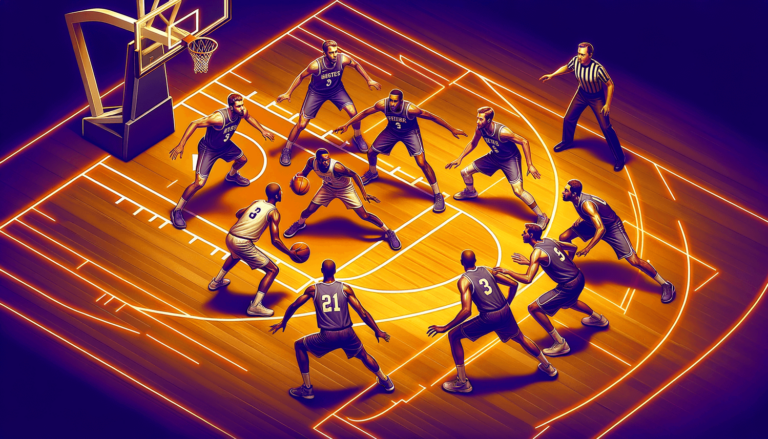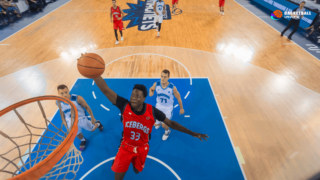
If you’re looking to delve into the strategic world of basketball defensive schemes, you’ve come to the right place! Welcome to our in-depth exploration of the fascinating 2-3-1 Zone Defense, a lesser-known but highly effective gem in a coach’s playbook. Widely used by top teams across various competitions, this tactical approach packs a powerful punch and offers a dynamic way to thwart opponents. So whether you’re a coach, player, or simply a basketball enthusiast eager to impress your friends with your hardwood wisdom, buckle up and get ready to immerse yourself in the ins and outs of the 2-3-1 Zone Defense!
What’s a 2-3-1 Zone Defense in Basketball?
A 2-3-1 Zone Defense in basketball is a defensive formation in which two players guard the perimeter, three players cover the middle areas, and one player patrols the baseline. This setup is designed to interrupt passing lanes, challenge opposing team’s perimeter shooting, and neutralize dominant post players. The 2-3-1 Zone Defense offers flexibility and adaptability, making it an excellent choice for teams seeking to stifle their opponents’ offensive strategies.
Breaking Down the 2-3-1 Zone Defense
Basketball as a dynamic and evolving sport, offers numerous defensive strategies, and the 2-3-1 Zone Defense is one that truly showcases the game’s intricacy. Let’s break it down and understand how the formation works within specific player positions, and how it challenges the opposition.
Positioning on the Court
In the 2-3-1 Zone Defense, players align themselves on the court as follows:
- Two players (guards) position themselves near the top of the key, focusing on the perimeter and denying access to the three-point line.
- Three players (forwards and/or centers) arrange themselves across the middle areas, effectively shutting down mid-range shots and driving lanes.
- One player (typically a forward or center) roams the baseline, providing additional support, controlling the low post, and acting as a secondary shot blocker.
This unique alignment on the court allows for effective coverage of various offensive threats and superior adaptability in response to shifting opposition strategies.
The Intricacies of the 2-3-1 Zone Defense
Now that we’ve grasped the basic formation, let’s delve deeper into the intricacies of the 2-3-1 Zone Defense, focusing on specific responsibilities and actions for each player throughout the possession.
Perimeter Players: (Guards) Defending the Three-Point Line
The two perimeter players hold the essential task of contesting and denying open shots from beyond the arc. These guards must showcase their exceptional agility and speed to quickly close out on shooters and apply pressure. Additionally, they need to communicate effectively and make seamless rotations to cover potential offensive breakdowns. Quick hands and anticipation are crucial for these players as they look to create turnovers and disrupt the opponent’s offensive rhythm.
Middle Players: (Forwards/Centers) Controlling the Mid-Range and Paint Area
The three middle players are responsible for shutting down mid-range shots, driving lanes, and contesting shots in the paint. These players must possess excellent lateral movement and solid footwork to switch between defending the perimeter and protecting the rim. The outer two players in the middle must also have the ability to quickly close out on corner three-point shooters to disrupt their effectiveness. These players should be adept at denying easy post-entry passes, boxing out for rebounds, and rotating to provide help defense when needed.
Baseline Player: (Forward/Center) Patrolling the Low Post
The baseline player is a critical component of the 2-3-1 Zone Defense, acting as the last line of defense and providing additional shot-blocking support. This player’s primary responsibility is to keep opposing big men in check and make them uncomfortable in the low post, forcing the opposition to take tough or low-percentage shots. Additionally, they need to be a strong rebounder and have the ability to communicate effectively with their teammates to coordinate defensive rotations.
Key Benefits of the 2-3-1 Zone Defense
While the 2-3-1 Zone Defense isn’t for every team, this formation brings multiple advantages that make it an enticing option for many coaches and players. Here is a rundown of some notable benefits:
Disrupting Your Opponent’s Offensive Flow
The 2-3-1’s aggressive approach to contesting perimeter shooting, combined with effective coverage of other areas of the court, can seriously disrupt the offensive flow of any team. By denying easy access to the three-point line, teams will face difficulty in executing their usual offensive strategies, leading to impulsive and lower-percentage shots.
Forcing Turnovers and Mistakes
The pressure generated by the 2-3-1 Zone Defense not only disrupts the offensive flow but also makes it harder for an offense to complete clean passes. Quick hands, strategic positioning, and proper communication allow defenders to stifle passing lanes and force the offense into mistakes, which in turn lead to turnovers and fast break opportunities.
Neutralizing Dominant Post Players
The multiple layers of defense in the 2-3-1 Zone make it difficult for opposing post players to establish a low post position or receive passes near the basket. The baseline player is tasked with containing such threats, forcing these players to move further from their comfort zone or take outside shots that aren’t part of their typical offensive arsenal.
Common Adjustments and Variations
One of the key reasons why the 2-3-1 Zone Defense is so versatile is its adaptability to a variety of adjustments and variations, based on the opponent’s style of play, strengths, and weaknesses. Let’s explore some common tweaks and variations a coach can adopt to respond to the opposing team’s tactics.
Trapping and Pressuring
A standard tweak in the 2-3-1 Zone Defense is to incorporate traps, especially along the perimeter and sideline areas. The defenders can employ high-pressure tactics to force the offensive ball handler to make hurried decisions, which can lead to more turnovers and rushed shots. The key to implementing this effectively is having quick, agile players who can cover the necessary ground and apply intense pressure.
Stretching the Defense
If the opponent has sharpshooters, it’ll be crucial to stretch the defensive assignments and extend the coverage beyond the arc. This adjustment requires the guards and forwards to close out on shooters faster, ensuring they don’t get open looks from the perimeter.
Adjusting Baseline Player’s Role
If the opponent is exceptionally adept at attacking the rim or lacks a dominant post player, it might be useful to switch the baseline player’s role to focus more on help defense and shot blocking. This change allows the player to provide additional support and reinforce the protective barrier around the hoop.
Implementing the 2-3-1 Zone Defense in Practice
The 2-3-1 Zone Defense is an incredibly effective and adaptable system, but it only achieves its potential through proper implementation and emphasis on teamwork. Here are some essential tips and suggestions for incorporating this defense into your team’s repertoire:
Player Skills and Attributes
It’s critical to acknowledge that not every player may be suitable for the 2-3-1 Zone Defense. The defensive scheme requires players to exhibit specific skills or physical attributes such as speed, agility, quick reflexes, and good communication. Ensure your players meet these criteria before committing to the 2-3-1 Zone Defense.
Drills and Preparation
Begin by incorporating focused drills into practice sessions to help players understand their roles and work on the necessary skills. For example, you can employ closeout drills, fast break reaction drills, and defensive rotations exercises to help your team get acquainted with the fundamentals of the 2-3-1 Zone Defense.
Communication and Trust
Emphasize the importance of communication and trust among your players. Encourage active conversation on the court, in terms of calling out screens or identifying potential threats. A successful 2-3-1 Zone Defense relies on the synchronicity between teammates and an unwavering commitment to the system.
Game Situations and Scrimmages
Finally, make sure to apply the 2-3-1 Zone Defense in game situations and scrimmages. This real-time application will help players adapt to the pace, pressure, and flow of a live game, eventually resulting in a smoother transition when employing the defense during actual competitions.
Conclusion
The 2-3-1 Zone Defense is a versatile and effective basketball defensive scheme that can be tailored to suit your team’s strengths and target your opponent’s weaknesses. Through a combination of strategic adjustments and focused practice, your squad can benefit from the disruptive capabilities of this unique defense. As you dedicate time and effort to mastering this system, you’ll be well on your way to stifling opposing offenses and increasing your chances of success on the court.
Essential Tips for Implementing 2-3-1 Zone Defense Successfully
For a smooth and successful incorporation of the 2-3-1 Zone Defense into your team’s game plan, it is crucial to pay attention to the following key aspects:
Mastering the Fundamentals
A solid foundation in fundamental basketball skills, such as agility, footwork, and awareness, is essential for players in the 2-3-1 Zone Defense. Before implementing this strategy, ensure that your players have refined basic skills like positioning, lateral movement, and rebounding. Additionally, hone your team’s anticipation skills and ability to read offensive plays, which play a significant role in effectively utilizing the 2-3-1 Zone Defense.
Analyzing the Opposition
This defensive scheme is most effective when tailored to counter the strengths of your opponents. Prior to your games, analyze your opposition’s style of play, preferred offensive strategies, and key scorers. Use this knowledge to adjust the 2-3-1 Zone Defense accordingly, targeting their primary scoring options and disrupting their rhythm.
Maintaining Flexibility
While the 2-3-1 Zone Defense offers numerous benefits, sticking to it rigidly can be counterproductive. It is essential to recognize when adjustments are needed or when switching to a different defensive scheme may offer better results. Be open to tweaking the rotation, altering responsibilities, or even changing the entire approach based on the flow of the game, ensuring that your team remains competitive and dynamic.
Comparing the 2-3-1 Zone Defense with Other Defensive Strategies
Understanding how the 2-3-1 Zone Defense compares with other popular defensive strategies will provide you with greater clarity regarding its advantages, as well as revealing the scenarios when other strategies might be better suited to your team’s needs.
2-3-1 Zone Defense vs. 2-3 Zone Defense
While the 2-3 Zone Defense also employs two players positioned near the top and three players across the middle, it lacks the extra baseline player present in the 2-3-1 Zone Defense. This additional player in the 2-3-1 system allows for increased baseline coverage, better control of the low post, and more help defense options. However, the 2-3 Zone Defense provides more substantial coverage in the middle, focusing on guarding the high post, paint area, and wings.
2-3-1 Zone Defense vs. 1-3-1 Zone Defense
The 1-3-1 Zone Defense uses a single player at the top, responsible for pressuring the ball handler and preventing penetration. While this enables the team to apply more pressure on opponents, the additional responsibilities placed on the top player may create vulnerabilities, particularly against a fast-paced offense. The 2-3-1 Zone Defense mitigates these weaknesses by utilizing two perimeter players, relieving pressure on the point of attack and offering stronger coverage on the wings.
2-3-1 Zone Defense vs. Man-to-Man Defense
In a man-to-man defense, each player is responsible for defending a specific opponent throughout the possession. This strategy relies on individual player skills and can encounter issues if there are mismatches in size, speed, or skill. The 2-3-1 Zone Defense addresses these limitations by allocating responsibility to specific areas of the court instead, promoting a more cohesive team approach and denying easy offensive opportunities for the opposition.
Examples of Successful 2-3-1 Zone Defense Implementation
Learning about successful implementations of the 2-3-1 Zone Defense in real-life scenarios can provide further insight and context on how this strategy can impact a game.
NCAA Basketball
The 2-3-1 Zone Defense has been employed to great effect at the college level by several NCAA basketball teams. Successful examples of this strategy include the Syracuse Orange and Louisville Cardinals; these teams utilize the 2-3-1 to disrupt their opponents’ offensive rhythm, leading to turnovers and low-percentage shots.
International Basketball
In international basketball competitions, such as FIBA and Euroleague, the 2-3-1 Zone Defense has also seen notable success. Teams like Spain, Lithuania, and Russia have implemented this defensive scheme to camouflage their weaknesses, target their opponents’ strengths, and achieve favorable results against high-powered offenses.
By studying these instances of the 2-3-1 Zone Defense in action, you can gather valuable knowledge on how and when to deploy
FAQ: Frequently Asked Questions about the 2-3-1 Zone Defense
In this FAQ section, we address ten commonly-asked questions related to the 2-3-1 Zone Defense in basketball, providing comprehensive yet concise answers to enhance your understanding of this defensive strategy.
1. What is the primary purpose of the 2-3-1 Zone Defense in basketball?
The primary purpose of the 2-3-1 Zone Defense is to disrupt the opposing team’s offensive rhythm by cutting off passing lanes, pressuring the perimeter, and neutralizing dominant post players.
2. How do I know if my team is suited for the 2-3-1 Zone Defense?
Your team will be well-suited for the 2-3-1 Zone Defense if your players possess the necessary skills, such as speed, agility, quick hands, excellent communication skills, and solid defensive instincts.
3. How is the 2-3-1 Zone Defense different from the 2-3 Zone Defense?
The 2-3-1 Zone Defense utilizes an additional baseline player to provide increased low post support, flexibility, and help defense options, whereas the 2-3 Zone Defense concentrates more on guarding the high post and paint area.
4. When should I consider using the 2-3-1 Zone Defense in a game?
Consider implementing the 2-3-1 Zone Defense if your opponent is characterized by a strong perimeter shooting presence, a dominant post scorer, or if you wish to disrupt their offensive flow and create turnover opportunities.
5. How can I adapt the 2-3-1 Zone Defense to counter specific offensive threats?
You can adapt the 2-3-1 Zone Defense by stretching the defense to cover sharpshooters, increasing trapping and pressuring, or adjusting the baseline player’s role to focus on help defense and shot blocking.
6. What are the critical factors to successfully implementing the 2-3-1 Zone Defense?
The critical factors for success in the 2-3-1 Zone Defense include mastering the fundamentals, commitment to teamwork, clear communication, and understanding your team’s strengths and your opponent’s weaknesses.
7. How do I integrate the 2-3-1 Zone Defense into practice sessions?
Integrate the 2-3-1 Zone Defense into practice through focused drills, such as closeout drills, defensive rotation exercises, and fast-break reaction drills. Encourage communication, teamwork, and trust among teammates.
8. Can the 2-3-1 Zone Defense be combined with other defensive strategies?
Yes, you can combine the 2-3-1 Zone Defense with other strategies or utilize them interchangeably based on your team’s needs and your opponent’s strengths. Maintaining flexibility and adaptability is key to your team’s defensive success.
9. What is trapping in the context of the 2-3-1 Zone Defense?
Trapping refers to a defensive tactic in which two defenders apply high-pressure to an offensive player to force rushed decisions, turnovers, or low-percentage shots. It can be incorporated into the 2-3-1 Zone Defense to enhance its effectiveness.
10. How does the 2-3-1 Zone Defense compare to man-to-man defense?
The 2-3-1 Zone Defense allocates responsibility based on specific court areas, while man-to-man defense assigns each player to defend a specific opponent. The 2-3-1 Zone Defense can address potential mismatches and deny easy offensive opportunities more effectively than man-to-man defense in certain scenarios.
Featured Posts
- No pillar pages found.





